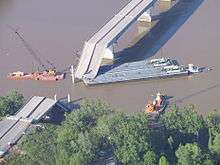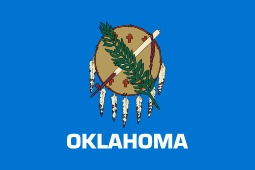I-40 bridge disaster

The I-40 bridge disaster was a bridge collapse that occurred southeast of Webbers Falls, Oklahoma, United States at 7:45 a.m. on May 26, 2002. Joe Dedmon, captain of the towboat Robert Y. Love, experienced a fainting spell and lost control of the tow. This, in turn, caused the barges he was controlling to collide with a bridge pier. The result was a 580-foot (176.78 m) section of the Interstate 40 bridge plunging into Robert S. Kerr Reservoir on the Arkansas River.[1] By the time traffic stopped and individuals became aware of the missing road, 8 passenger vehicles and 3 truck tractor-semitrailer combinations had fallen into the river or on collapsed bridge pieces. Fourteen people died and eleven others were injured when several automobiles and tractor-trailers fell from the bridge. Survivors were aided by fishermen who were participating in a bass fishing tournament in the river near the bridge.[2]
Rescue and recovery
Three people that had fallen into the river in their vehicles were able to get out and swim to shore.[3] While fishing in a bass fishing tournament, fishermen on the water saw the disaster occurring and attempted to aid the victims and stop the cars and trucks they witnessed driving towards the bridge failure. One fisherman along the river shot a flare at a tractor-trailer driver in an attempt to get the truck to stop.[4] Others threw ropes at individuals in vehicles to attempt to pull them from the water.[2]
Rescue efforts were complicated when William James Clark, impersonating a U.S. Army captain, was able to take command of the disaster scene for two days. Clark's efforts included directing FBI agents and appropriating vehicles and equipment for the rescue effort, before fleeing the scene. Clark, already a two-time felon, was later apprehended in Canada.[5]
An estimated 20,000 vehicles per day were rerouted for about two months while crews rebuilt the bridge. Traffic resumed Monday, July 29, 2002, only two months after the disaster. The reopening set a new national record for such a project, which would normally be expected to take six months.[6]
Investigation and litigation
It was reported that the towboat Robert Y. Love had problems with manning the steering back in 1994, although Coast Guard Lt. j.g. Natalie Magnino claimed that at the time, the problem was caused by debris that had jammed the rudder and was not the result of mechanical failure or pilot error.[2]
The National Transportation Safety Board stated in 2004 that the collapse was due to Captain Dedmon's loss of consciousness, possibly due to an unforeseeable abnormal heart rhythm.[1] University of Indiana Professor of Medicine Douglas Zipes, agreed with this explanation and stated in a letter to Dedmon's attorney that it was likely that Dedmon had ventricular tachycardia, which caused him to black out.[7] As a result of the accident the Safety Board recommended that the U.S. Coast Guard Research and Development Center, evaluate the utility and effectiveness of alerter systems within the wheelhouse of inland towing vessels. This was in addition to warning systems for motorists to stop in the case of a partial or total bridge collapse.
In May 2003, victims of the bridge collapse settled a lawsuit with the owner of the towboat company that caused the bridge to collapse. The Mississippi based company Magnolia Marine Transport Co. settled with the 14 deceased victims families and those injured for an undisclosed amount.[7] This is separate from the other suits against the company by the state of Oklahoma and MBO Video.
Memorials
On Memorial Day 2003, that year on May 26, a memorial statue was dedicated by Oklahoma Governor Brad Henry in Webbers Falls, Oklahoma.
Webbers Falls marked the 15th Anniversary of the bridge collapse with a special ceremony at the Webbers Falls Historical City Park, with the monument in honor of those who were affected by the accident.[3]
The town created a memorial statue in honor of the victims and the event, which is a 14ft tall bronze sculpture that incorporates pieces of the wreckage and is topped by a young girl reaching upwards to release a dove. The young girl represents the youngest victim, a 3 year-old girl. It was created by Shahla Rahimi-Reynolds, who was chosen by the Webbers Falls Committee to design the memorial, which also uses 14 granite plaques to memorialize each victim. The memorial was dedicated on May 26, 2003.[8] To complete the memorial the State utilized almost $150,000.[9]
See also


- List of bridge disasters
- List of crossings of the Arkansas River
- Tasman Bridge disaster - 7,000 ton ore-carrier hit bridge piers causing collapse of roadway
- Queen Isabella Causeway - A similar accident in 2001
- Granville railway disaster - Train hits piers
- Big Bayou Canot train disaster - Amtrak train plunged off bridge that had been hit by a barge.
References
- 1 2 National Transportation Safety Board Office of Public Affairs (August 31, 2004). "NTSB News Release: NTSB Determines Cause of I-40 Bridge Collapse in Oklahoma". www.ntsb.gov. Retrieved April 19, 2018.
- 1 2 3 "CNN.com - Death toll rises to 13 in bridge collapse - May 28, 2002". edition.cnn.com. Retrieved 2018-04-20.
- 1 2 Writer, Wendy Burton / Phoenix Staff. "Ceremony set to honor I-40 bridge collapse victims". Muskogee Phoenix. Retrieved 2018-04-20.
- ↑ "May 27, 2002 — I-40 bridge collapse kills 14". Tulsa World. Retrieved 2018-04-20.
- ↑ "Man convicted for bridge fraud". 10th circuit court of appeals. Retrieved 2010-08-29.
- ↑ "Traffic flows again on I-40 bridge". NewsOK.com. 30 July 2002. Retrieved April 11, 2015.
- 1 2 "Victims of I-40 bridge collapse reach settlement with towboat owner". NewsOK.com. 2003-05-22. Retrieved 2018-04-20.
- ↑ "Webbers Falls, Oklahoma". Webbers Falls, Oklahoma. 2014-03-29. Retrieved 2018-04-20.
- ↑ "Memorial set for victims of I-40 bridge collapse". NewsOK.com. 2003-01-05. Retrieved 2018-04-20.